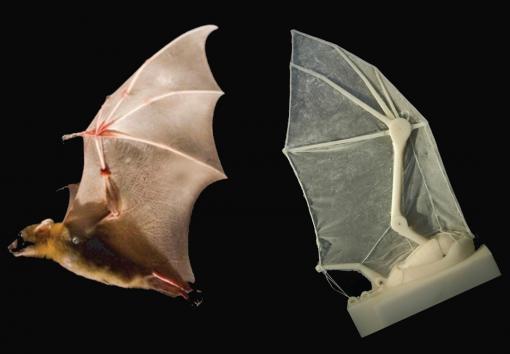The strong, flapping flight of bats looks fun but mimicking the function of ligaments, the elasticity of skin, the structural support of musculature, skeletal flexibility, upstrokes and downstrokes robotically also offers great possibilities for the design of small aircraft.
In a flapping animal, positive lift is generated by the downstroke, but some of that lift is undone by the subsequent upstroke, which generates negative lift. By running trials with and without wing folding, the robot showed that folding the wing on the upstroke dramatically decreases that negative lift, increasing net lift by 50 percent.
Bat wings are complex things. They span most of the length of a bat's body, from shoulder to foot. They are supported and moved by two arm bones and five finger-like digits. Over those bones is a super-elastic skin that can stretch up to 400 percent without tearing. The eight-inch robot mimics that anatomy with plastic bones carefully fabricated on a 3-D printer to match proportions of a real bat. The skin is made of a silicone elastomer. The joints are actuated by servo motors that pull on tendon-like cables, which in turn pull on the joints.

The strong, flapping flight of bats offers great possibilities for the design of small aircraft, among other applications. By building a robotic bat wing, Brown researchers have uncovered flight secrets of real bats: the function of ligaments, the elasticity of skin, the structural support of musculature, skeletal flexibility, upstroke, downstroke. Credit: Breuer and Swartz Labs / Brown University
The robot doesn't quite match the complexity of a real bat's wing, which has 25 joints and 34 degrees of freedom. An exact simulation isn't feasible given today's technology and wouldn't be desirable anyway, Bahlman said. Part of why the model is useful is that it distills bat flapping down to five fundamental parameters: flapping frequency, flapping amplitude, the angle of the flap relative to the ground, the amount of time used for the downstroke, and the extent to which the wings can fold back.
Experimental data aside, Bahlman said there were many lessons learned just in building the robot and getting it to work properly. "We learned a lot about how bats work from trying to duplicate them and having things go wrong," he said.
During testing, for example, the tongue and groove joint used for the robot's elbow broke repeatedly. The forces on the wing would spread open the groove, and eventually break it open. Bahlman eventually wrapped steel cable around the joint to keep it intact, similar to the way ligaments hold joints together in real animals.
The fact that the elbow was a characteristic weak point in the robot might help to explain the musculature of elbows in real bats. Bats have a large set of muscles at the elbow that are not positioned to flex the joint. In humans, these muscles are used in the motion that helps us turn our palms up or down. Bats can't make that motion, however, so the fact that these muscles are so large was something of a mystery. Bahlman's experience with the robot suggests these muscles may be adapted to resist bending in a direction that would break the joint open.
The wing membrane provided more lessons. It often tore at the leading edge, prompting Bahlman to reinforce that spot with elastic threads. The fix ended up looking a lot like the tendon and muscle that reinforce leading edges in bats, underscoring how important those structures are.
Now that the model is operational, Bahlman has lots of plans for it.
"The next step is to start playing with the materials," he said. "We'd like to try different wing materials, different amounts of flexibility on the bones, looking to see if there are beneficial tradeoffs in these material properties."
Citation: Joseph W Bahlman, Sharon M Swartz and Kenneth S Breuer, 'Design and characterization of a multi-articulated robotic bat wing', Bioinspiration&Biomimetics Volume 8 Number 1 doi:10.1088/1748-3182/8/1/016009 (FREE TO READ)





Comments